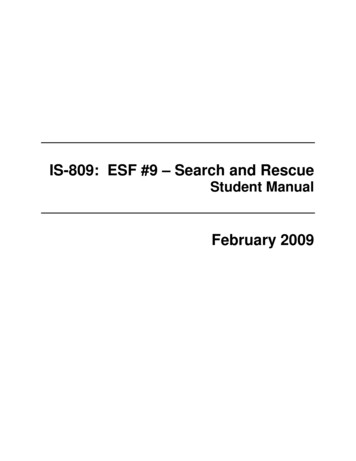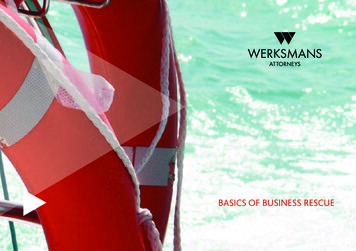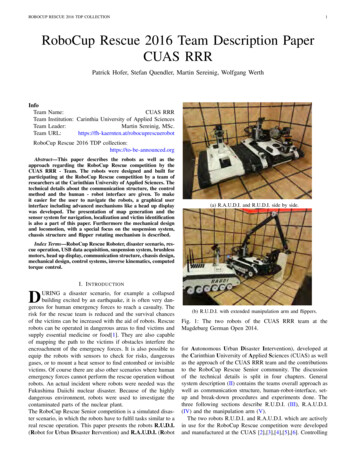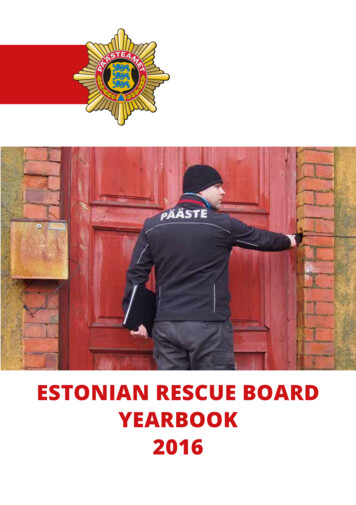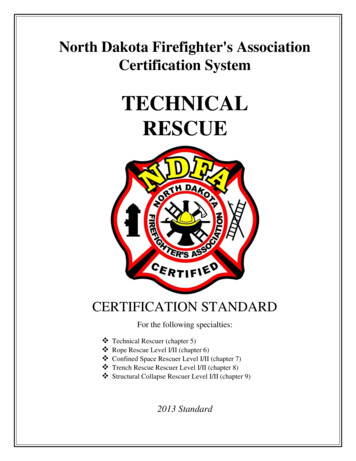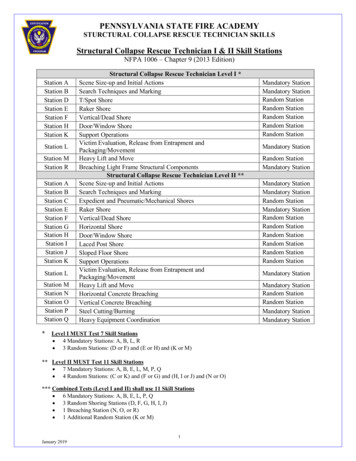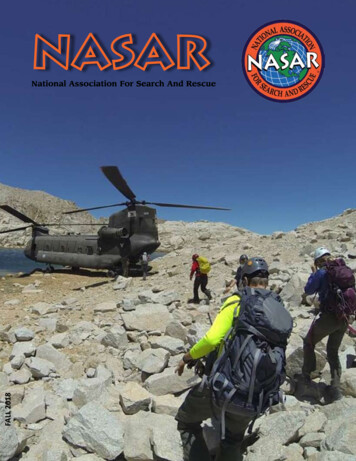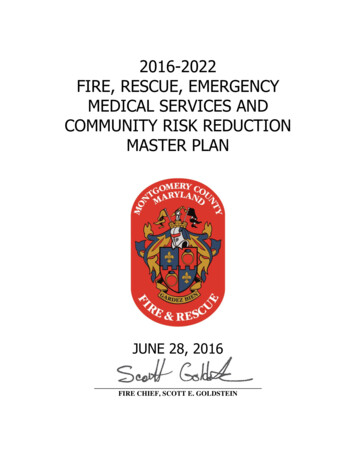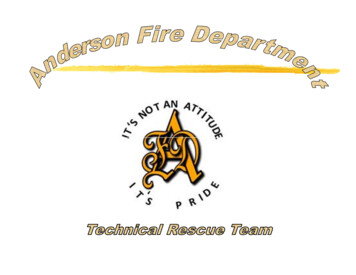
Transcription
Technical Rescue: AwarenessThis course is necessary for our Rescue Team tostay up-to-date with NFPA.It is also necessary to educate other respondersto recognize a technical rescue incident and beaware of their limitations.The course was developed for other agencies,not just the fire departments.
Technical Rescue: AwarenessCourse Outline1.2.3.4.5.6.IntroductionPre-testNFPA 1670 & NFPA 1006VideoClassroom ScenariosFinal Test
Technical Rescue: AwarenessCourse Objectives1. Define Technical Rescue2. Explain the three levels of response to atechnical rescue3. Understand the role of the first responderat a technical rescue4. Recognize the limitations of responderstrained to the awareness level5. Size-up a rescue situation
Technical Rescue: AwarenessCourse Objectives (cont.)6. Know whom to call for assistance forvarious types of rescue situations7. Secure the scene at a rescue incident8. Describe the hazards that may be present ateach type of rescue9. Know techniques to help victims self-rescue10.Explain the four basic types of construction11.Describe the five types of collapse patterns
Pre-TestThe pre-test is to get you thinking about TechnicalRescue and to find out how much you already know.There is no passing or failing grade.
Pre-Test1. List several situations which may require a technicalrescue.Seven basic rescue scenarios are identified by theNational Fire Protection Association and are covered inthis program: Confined Space, Rope, Structural Collapse,Trench, Vehicle/Machinery, Water and Wilderness2. Name some of the equipment that rescuers might use.There are a number of pieces of basic rescue equipmentused by responders: ropes, ladders, retrieval lines, tripods,ventilation equipment, for trenches and confined spaces,shoring equipment, air monitoring equipment, fallprotection devices, thermal imaging cameras, protectiveequipment like hard hats.
Pre-Test3. List some activities that those first on the scene of arescue situation should carry out.First on-scene rescuers trained to the awareness level areresponsible for assuming command until relief arrives,sizing up the situation, calling for assistance, identifyinghazards, securing the site to keep out citizens, ventilation,helping victims with self-rescue, and assisting operationsand technician-level rescue personnel once they arrive.4. List some of the hazards that might exist at a buildingcollapse.Some potential hazards include secondary collapse; fires;potential for explosion if utilities are live; gas leaks;hazardous materials at industrial locations.
Pre-Test5. Describe some of the ways first responders might beable to assist a victim of a confined space incidentwithout entering the space.Awareness level rescuers may drop ladders and ropes,attach and hoist retrieval lines, ventilate the area if toxicfumes are feared, and shut off utilities to preventexplosions. DO NOT ENTER THE SPACE!6. What information should first responders gather about arescue incident to pass on to the rescue team?How many victims? What is their condition? Are they incommunications with the rescuers? What is the scope ofthe incident? What are the hazards of the situation? Whatresources will be necessary to conduct a rescue? Is theresponsible party on scene? Are witnesses available? Willthe weather be a factor?
Pre-Test7. What are the limitations of the role of the rescuertrained to the awareness-level?If first responders on scene are not trained and equippedfor a technical rescue they must not enter the hazardarea.8. Why is it important for rescuers to be knowledgeable ofvarious construction types?In a structural collapse, materials of construction willdetermine the equipment needed for rescue and mayindicate the type of collapse pattern to be expected andwhere void spaces may exist where victims have survived.Knowing the materials of construction may also help todetermine the likelihood of secondary collapse. There arefour basic types of construction, light frame construction,heavy wall construction, heavy floor construction, precast construction.
Pre-Test9. What are some of the hazards that might be present atthe scene of a suspected terrorism incident?A terrorist event presents some special challenges forresponders. There are likely to be massive numbers ofvictims and public hysteria. Rescuers must be particularlycautious for secondary devices and sniper-type activity.Other chemical or biological agent releases or otherhazardous materials in the area.10. What are some ways to reduce the dangers of a rescueoperation?Rescuers must never attempt a rescue without propertraining or equipment. Rescue teams should trainvigorously and often in various types of technical rescues,and should refine response plans continually. Rescueteams should follow procedures at all times. A safetyofficer must be appointed at each rescue, and life supportteams should be on scene.
Technical RescueWhat is the NFPA?National Fire Protection AssociationNon-profit educational and technical associationdevoted to protecting life and property from fire bydeveloping fire protection standards and educating thepublic. (IFSTA – FD Company Officer)Are you required to follow NFPA Standards?No, but these are the standards that legalrepresentatives will use against you in a court oflaw.
Technical Rescue“Technical rescue isthe application ofspecial knowledge,skills, and equipmentto safely resolveunique and/or complexrescue situations.”
Where did Technical RescueAwareness originate?NFPA 1670Standard onOperations andTraining forTechnical RescueIncidentsEffective February 4,1999NFPA 1006Standard for e February11, 2000
For This Class, We WillFocus onStandards on Operationsand Training for TechnicalRescue Incidents
Intent of the StandardEstablish general guidelines for the AuthorityHaving Jurisdiction (AHJ) in:Assessing technical rescue hazardsIdentifying levels of operationalcapabilitiesEstablishingTraining documentation andResponse guidelines
Authority Having JurisdictionThe organization,office, or individualresponsible forapproving equipment,an installation, or aprocedure.
Organizations covered:Any agency thatresponds to technicalrescue incidentsFire departmentsLaw enforcementEmergency medicalservicesUtilityPublic worksRescue organizations
Rescue inedSpaceRopeWaterWildernessSearch &RescueTrenchCollapse
Levels of FunctionalCapabilityTechnicianOperationsAwareness
AwarenessMinimum capabilitiesEncounter a technicalrescue in regular duties by Response to First on scene ofAuthorityNot considered a rescuerLevelSearchRescueRecovery
OperationsSupport capabilityHazard recognitionEquipment useTechniquesAuthoritySupervised by a TechnicianLevelSearchRescueRecovery
TechnicianCapabilityHazard recognitionEquipment velSearchRescueRecovery
Technical Rescue: ReviewPre-testDefined NFPA and the intent of NFPA 1670 & 1006Defined Technical Rescue:“Technical rescue is the application of special knowledge, skills, andequipment to safely resolve unique and/or complex rescue situations.”Explained the Seven Rescue Disciplines:Rope, Trench Collapse, Structural Collapse, Water, Vehicle/Machinery,Wilderness and Confined Space.Explained the Three Levels of response capabilities:Awareness, Operations and TechnicianDefined – AHJ (Authority Having Jurisdiction)
Technical Rescue: NextNFPA 1670 uses a building block approach for developingresponse capabilities.Levels sometimes overlap to build a specific discipline.Responsibilities of the AHJ (Authority HavingJurisdiction)
Water RescueDiveIceSurfSwiftwaterRopeNFPA 472 HAZMAT AwarenessRope
“Swiftwater”Water moving at arate greater than 1knot1.15 mph1.66 ft/sec1.85 km/hr
Confined PA 472HAZMAT Awareness
Wilderness Search & RescueWaterTechnicianRopeRopeOperationsAwareness
Trench & ceVehicles& MachineryRopeConfinedSpaceVehicles& MachineryNFPA 472HAZMAT Awareness
Vehicle & MachineryTechnicianOperationsNFPA 472HAZMAT OperationsAwarenessNFPA 472HAZMAT Awareness
Structural & MachineryRopeConfinedSpaceTrenchVehicles& MachineryRopeConfinedSpaceTrenchConfinedSpace
Requirements for the AHJAs required by NFPA 1670, each agency mustselect the appropriate level(s) of capability forall of its personnel. In addition to determiningthose levels, the AHJ must also satisfy anumber of general requirements in order to befully NFPA compliant.Examples of those requirements are:
Basic Life SupportALS recommendedTraining in addition toBLSCervical/spinalimmobilization Vertical packaging Horizontal packagingCrush injury syndrome Recognition Evaluation Treatment
Standard Operating GuidelinesPerformed in a safemannerConsistent withoperational capabilityAlso used forTrainingBody recoveryEvidence searchOther urgentoperations
TrainingAwareness minimumContinuing educationprogramAnnual performance reviewDocumentationNamesTrainer signatureDatesOutlineResource material
AccountabilityNFPA 1561 § 2-6Assists the IncidentCommander andSafety Officer withsite managementRapid accountingRapid evacuation Audible warning Visual warning Radio warning
Technical Rescue: ReviewRequirements for each of the Seven Rescue Disciplines:Rope – Awareness, Operations and TechnicianWater – Awareness, Operations and TechnicianConfined Space –Awareness, Operations and TechnicianWilderness – Awareness, Operations and TechnicianTrench – Awareness, Operations and TechnicianVehicle/Machinery – Awareness, Operations and TechnicianStructural Collapse - Awareness, Operations and TechnicianRequirements for the AHJ:Basic Life SupportSOG’sTrainingAccountability
Technical Rescue: NextVideo – Technical Awareness AwarenessClassroom ScenariosFinal Written Test
Scenario #1You are outside a structure in the downtown area and you heara rumble.The two highway patrolmen are shouting that there are twopeople inside this structure.
Scenario #1
Scenario #1Is this a Technical Rescue?“Technical rescue is the application of specialknowledge, skills, and equipment to safely resolveunique and/or complex rescue situations.”What type of Technical Rescue Incident is this?Structural CollapseWhat type of collapse?Lean-toWhat Level of Responders will be needed?Building Collapse – Technicians and OperationsWhat actions can you take?
Scenario #2You are at a coffin vault manufacturing company picking out avault when someone comes in screaming that a young man hasfallen into the gravel hopper.You rush outside to the hopper and this is what you see.
Scenario #2
Scenario #2Is this a Technical Rescue?“Technical rescue is the application of specialknowledge, skills, and equipment to safely resolveunique and/or complex rescue situations.”What type of Technical Rescue Incident is this?Confined Space:(1)Is large enough and so configured that an employee can bodily enter and perform assignedwork(2)Has limited or restricted means of entry or exit (for example, tanks, vessels, silos, storagebins, hoppers, vaults and pits are spaces that may have limited means of entry)(3)Is not designed for continuous employee occupancyWhat Level of Responders will beConfined Space –needed?Technicians and OperationsWhat actions can you take?
Scenario #3You are in a rural subdivision after a flash flood.Someone tells you that there are people inside the house.
Scenario #3
Scenario #3Is this a Technical Rescue?“Technical rescue is the application of specialknowledge, skills, and equipment to safely resolveunique and/or complex rescue situations.”What type of Technical Rescue Incident is this?WaterWhat Level of Responders will beWater Rescue – Techniciansneeded? and OperationsWhat actions can you take?
Scenario #4You are hiking in the woods and come across several otherhikers.They tell you one of their member has become separated fromthem and they have been searching for him for two hours.
Scenario #4
Scenario #4Is this a Technical Rescue?“Technical rescue is the application of specialknowledge, skills, and equipment to safely resolveunique and/or complex rescue situations.”What type of Technical Rescue Incident is this?WildernessWhat Level of Responders will beWilderness Search& Rescue – Technicians andneeded?Operations / SAR Tech I & IIWhat actions can you take?
POST SEMINARTEST DISCUSSION1. Technician level training is for responders who arrivefirst on the scene of a technical rescue incident.This statement is false. Technician level training is forresponders who enter the hazard area to effect the rescue. Firston-scene-responders should be trained to the awareness level.2. The first responding unit at a rescue incident assumescommand until relieved by a ranking official. .This statement is true.3. Civilian rescuers should be allowed uncontrollable accessto the rescue scene. .This statement is false. The activities of civilians and volunteersshould be controlled by responders in command of the rescue.
4. First responders should not call for outside help untilinitial rescue efforts fail.This statement is false. First responders must call for help andadditional resources immediately, before initiating rescue efforts.Thus, should the effort fail, rescuers with the appropriate trainingand equipment are already en route.5. Determining the number and condition of victims is apart of size-up activities . .This statement is true.6. The responsible party (I.e., employer or property owner) .should be removed from the incident immediately . .This statement is false. The responsible party should be brought tothe command post as he or she may be a valuable source ofinformation.
7. At a confined space incident, first responders can lowerladders to allow the victim to self-rescue.This statement is true.8. Rescuers trained to the awareness level may enter aconfined space for rescue purposes. . .This statement is false. Awareness level training does not preparea responder for this activity. First responders trained at theawareness level must call for special rescue teams with specializedtraining and equipment to enter a confined space for rescue.9. For structural collapse rescues, first responders need to befamiliar with four basic types of construction. .This statement is true. The four basic types are: light frame, heavywall, heavy floor, and pre-cast construction.
10. In structural collapse, there are four types of collapse.patterns.This statement is false. There are five types of structuralcollapse patterns: lean-to, V-shape, pancake, cantilever, and Aframe collapse.11. In a cantilever collapse, bearing walls fail and an .upper floor drops onto a lower floor. . .This statement is false. In a cantilever collapse, a wall fails and oneend of a floor hangs free.12. After a structural collapse, unusual sounds may indicate animpending secondary collapse. .This statement is true. Other signs include: walls that lean morethan 10%, smoke or water seeping through joints, expandingdiagonal cracks, recurring after-shocks, sagging floor or roofassemblies, damaged points of connection of structural elements,excessive loading of structural elements, sliding plaster and airbornedust, racked or twisted structure, and sudden vibration.
13. After a structure collapse, a hot zone should be.established which includes a distance equal to the.height of the structure involved in the collapse.This statement is false. The hot zone should be a distance equalto the height of the structure plus one-third.14. When placing ladders at a trench collapse, the bestapproach is at the middle of the trench. . This statement is false. The best approach is from the ends of thetrench.15. Spoil pile and shear wall are two types of trench collapse .patterns. . . .This statement is true.
16. At a trench collapse, development of fissures may.indicate a secondary collapse.This statement is true. Another sign of secondary collapse issmall amounts of material suddenly rolling down into theexcavation.17. In a shore based water rescue, the first action should .be to try to reach to the victim with a pole or otherdevice.This statement is true.18. Awareness –level rescuers use rope-based raising and lowering systems to rescue victims. . . . .This statementis false. Awareness-level trained respondersare nottrained to operate technical rescue equipment.
19. The National Fire Protection Association recognizes.three levels of training for those involved in a technical.rescue.This statement is true. The three levels are Awareness,Operations and Technician20. Responders trained at the awareness level can . determine the hazards present at a technical rescueincident.This statement is true. This activity is part of the first responderssize-up activity.
ConclusionDid we meet our objectives?1. Define Technical Rescue (#13)2. Explain the three levels of response to atechnical rescue (#20)3. Understand the role of the first responder ata technical rescue (#8)4. Recognize the limitations of responderstrained to the awareness level (#21)5. Size-up a rescue situation (#41-51Scenarios)
Conclusion6. Know whom to call for assistance for varioustypes of rescue situations7. Secure the scene at a rescue incident (video)8. Describe the hazards that may be presentat each type of rescue (video)9. Know techniques to help victims selfrescue (video)10. Explain the four basic types of construction(#10)11. Describe the five types of collapse patterns(video)
Technical Rescue: Awareness Course Objectives 1. Define Technical Rescue 2. Explain the three levels of response to a technical rescue 3. Understand the role of the first responder at a technical rescue 4. Recognize the limitations of responders trained to the awareness level 5. Size-up a rescue situation
